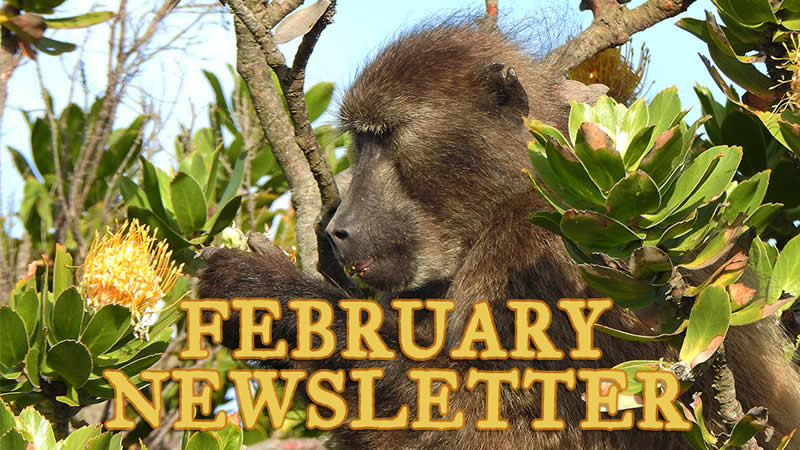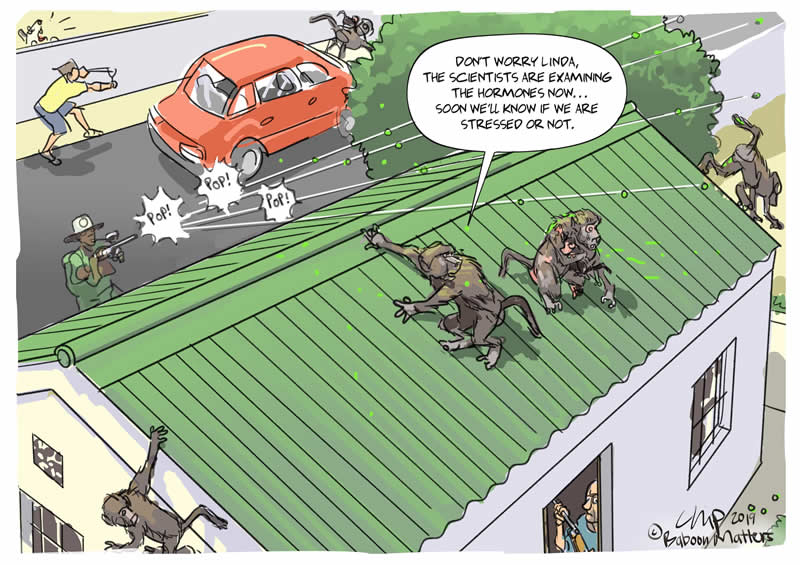How right Pete is! The drama of baboon management has played out in all media over this year but escalated incredibly with the ‘Katazagate’ scenario! Who would have thought that Kataza would become the most famous baboon in the world? He has been become a social-media star, a twitter trend, been seen on news features and press internationally and nationally and is known by everyone no matter where he goes.
We have watched with degrees of concern, sadness and despair as this male baboon struggled to come to terms with having been uprooted from Kommetjie and set down in Tokai to find a new troop. Our frustration and anger at the lack of transparency and lack of action from decision makers was rife and inspired animal rights activist Ryno Engelbrecht to start legal action. We protested and petitioned and far from public attention dying down, as the CoCT had hoped, interest in Kataza has always escalated and never waned.
Katazagate in a nutshell.
Kataza is one of two adult male baboons of the Slangkop troop who were moved back into the Kommetjie home-range in January 2020 after rangers had been held up and robbed whilst on duty in the Ocean View range.
Moving the troop back to Kommetjie illustrated on-going and underlying management problems such as poor communication, minimal education, little community involvement and no baboon proof bins – which should be provided by CoCT Solid Waste Dept.
There is no water on the Slangkop range in the hot, dry summer months and TMNP had not allowed any water provisioning sites so the troop started coming in to Kommetjie, essentially for water, but they quickly rediscovered “hot-spot” areas where they could access rich rewards of food found in bins or inappropriately thrown away – such as household waste being dumped into green bins designated for pedestrian use.
The entire troop utilized the easy food rewards obtained in Kommetjie, no single baboon was seen to be a more excessive opportunist than any other baboon. The troop all arrived together and were normally herded out of the village together, there are always a few stragglers but residents did not notice any factions or splitting within the troop.
In the ensuing months, residents complained about the excessive use of paintballs on the baboons and noted how the troop scattered all over the village as a result of the aggressive management.
The Slangkop troop arriving back in Kommetjie was almost immediately followed by the global Covid pandemic and national lockdown and it seems that the timing of baboons in the village, along with national stress and concerns about income, health and safety all combined into one simmering mess of tension. Baboons were injured by dogs, shot at by pellets and high velocity paintball guns – but continued to come into the village and even started sleeping in Kommetjie overnight.The Slangkop troop arriving back in Kommetjie was almost immediately followed by the global Covid pandemic and national lockdown and it seems that the timing of baboons in the village, along with national stress and concerns about income, health and safety all combined into one simmering mess of tension. Baboons were injured by dogs, shot at by pellets and high velocity paintball guns – but continued to come into the village and even started sleeping in Kommetjie overnight.
Setting the records straight
Local resident Bradley Thorsen collated data from the daily WhatsApp groups where sightings of baboons in the village are reported and noted discrepancies in the management reports, specifically with the times recorded for baboons being in the village. His expressed concerns were dismissed by the service provider as being “irrelevant” nonetheless his accurate data was able to prove when baboons had been in the village and if any baboon had accrued more misdemeanors than any other baboon. Thank you Bradley for keeping the records!
Towards the end of August I noticed that Kataza was not with his troop, at first I thought that perhaps I had just missed seeing the big lad, but I asked Bradley and Susan Litten (our Kommetjie Councilor Appointed Rep – Baboons South) to help me check. Over the next few days none of us could find Kataza. Susan queried his disappearance and we were told that Kataza had been “relocated” to Tokai – the reasons being that he was “splitting the troop”, that he was inbreeding as he should have dispersed and that he was the deemed to have the worst “raiding record”.
As this poor decision came to light baboon experts of UCT were quick to defend the Baboon Technical Team – Esme Beamish (independent researcher – ICWild) was reported as noting that Kataza was not seen consorting with the females when she completed her annual counts of the troop over a few months in 2020. Justin O’Riain (ICWild) noted that Kataza could not possibly have offspring, or that off spring would have been in utero. It was confusing to hear reports that:
- Kataza was not consorting with females of his troop, yet it was claimed that Kataza was leading a splinter group of low ranking females; perhaps this was the first platonic splinter troop in baboon history?
- Kataza was inbreeding yet is was also claimed that
- Kataza had no offspring
- George (remaining adult male of the troop) killed 5 infants (as males sometimes do commit infanticide when there is a change in dominance). So George thought Kataza had babies? A bad mistake George?
- Kataza was a “problem raiding baboon”
- He was not proven to be any worse than any other baboon of this habitually opportunistic raiding troop.
But despite what we, collectively, thought about the decision making or the outcome, the CoCT proved to be intractable and simply refused to answer emails, or engage to resolve the issue…. Kataza gained celebrity status as he went in and out of Pollsmoor Prison and the American Embassy while the CoCT gained notoriety status for doing nothing.






















































